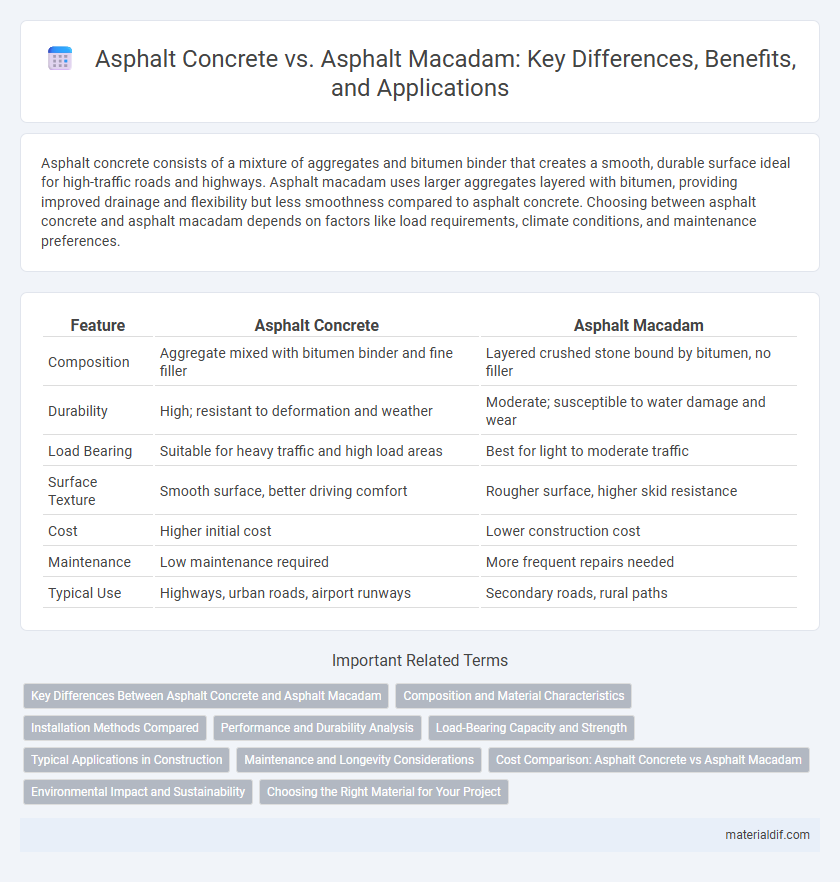Asphalt concrete consists of a mixture of aggregates and bitumen binder that creates a smooth, durable surface ideal for high-traffic roads and highways. Asphalt macadam uses larger aggregates layered with bitumen, providing improved drainage and flexibility but less smoothness compared to asphalt concrete. Choosing between asphalt concrete and asphalt macadam depends on factors like load requirements, climate conditions, and maintenance preferences.
Table of Comparison
| Feature | Asphalt Concrete | Asphalt Macadam |
|---|---|---|
| Composition | Aggregate mixed with bitumen binder and fine filler | Layered crushed stone bound by bitumen, no filler |
| Durability | High; resistant to deformation and weather | Moderate; susceptible to water damage and wear |
| Load Bearing | Suitable for heavy traffic and high load areas | Best for light to moderate traffic |
| Surface Texture | Smooth surface, better driving comfort | Rougher surface, higher skid resistance |
| Cost | Higher initial cost | Lower construction cost |
| Maintenance | Low maintenance required | More frequent repairs needed |
| Typical Use | Highways, urban roads, airport runways | Secondary roads, rural paths |
Key Differences Between Asphalt Concrete and Asphalt Macadam
Asphalt concrete consists of a dense mixture of bitumen and aggregate that is heated and compacted to create a smooth, durable surface ideal for high-traffic roads, while asphalt macadam features layers of crushed stone bound with bitumen, offering a more flexible pavement structure suited for lower-load areas. The key differences lie in their composition, with asphalt concrete providing superior load-bearing capacity and smoother finish compared to the open-graded, more permeable surface of asphalt macadam. Asphalt concrete's enhanced durability and resistance to deformation make it the preferred choice for highways, whereas asphalt macadam is commonly used for rural roads and base layers.
Composition and Material Characteristics
Asphalt concrete consists of a dense mixture of mineral aggregates, bitumen binder, and filler, providing high durability and load-bearing capacity due to its dense-graded aggregates and strong binder content. Asphalt macadam, also known as bituminous macadam, features a larger, open-graded aggregate base bound with bitumen, resulting in improved drainage but lower structural strength compared to asphalt concrete. The key difference lies in aggregate size and compaction, where asphalt concrete uses finer aggregates and higher compaction for a smoother, more impervious surface, whereas asphalt macadam allows for better water permeability and flexibility.
Installation Methods Compared
Asphalt concrete is installed using a hot mix process where aggregates are coated with bitumen at high temperatures and compacted with heavy rollers, ensuring a dense, smooth surface ideal for heavy traffic. Asphalt macadam involves layering crushed stone aggregates with bitumen binder, typically compacted in smaller sections, allowing easier repairs but resulting in a less uniform finish. The installation of asphalt concrete requires specialized equipment and precise temperature control, while asphalt macadam can be laid with simpler tools, making it more cost-effective for lighter-use roads.
Performance and Durability Analysis
Asphalt Concrete offers superior durability and load-bearing capacity compared to Asphalt Macadam due to its dense composition of asphalt binder and fine aggregates, resulting in enhanced resistance to deformation and weathering. Asphalt Macadam, with coarser aggregate layers and less binder content, tends to have lower performance under heavy traffic and is more susceptible to water infiltration and rutting. Performance analysis consistently shows that Asphalt Concrete maintains structural integrity longer, requiring less frequent maintenance in high-stress environments.
Load-Bearing Capacity and Strength
Asphalt concrete demonstrates superior load-bearing capacity and strength compared to asphalt macadam, attributed to its dense mix of aggregates bound by high-quality bitumen. The carefully engineered gradation in asphalt concrete enhances stability, making it ideal for high-traffic roads and heavy-duty pavements. Asphalt macadam, while offering moderate strength, lacks the compactness and durability required for supporting heavy loads over extended periods.
Typical Applications in Construction
Asphalt concrete is primarily used for high-traffic roads, highways, and airport runways due to its durability and smooth finish, providing superior load-bearing capacity. Asphalt macadam, consisting of layered crushed stone bound with bitumen, is typically applied in rural roads, parking lots, and base courses where flexibility and drainage are essential. Both materials support different construction needs, optimizing performance based on specific structural and environmental demands.
Maintenance and Longevity Considerations
Asphalt concrete offers superior durability and requires less frequent maintenance compared to asphalt macadam, thanks to its dense, smooth surface that resists water infiltration and wear. Asphalt macadam, composed of larger aggregates and a coarser texture, tends to deteriorate faster under heavy traffic and harsh weather conditions, necessitating more frequent repairs and resurfacing. Choosing asphalt concrete enhances pavement longevity and reduces overall lifecycle costs by minimizing the need for routine maintenance and early replacement.
Cost Comparison: Asphalt Concrete vs Asphalt Macadam
Asphalt concrete typically incurs higher initial costs than asphalt macadam due to its denser composition and enhanced durability, which reduces long-term maintenance expenses. Asphalt macadam is generally more cost-effective for projects with budget constraints but may require more frequent repairs and resurfacing. The choice between the two materials depends on balancing upfront investment against lifecycle maintenance costs.
Environmental Impact and Sustainability
Asphalt concrete, composed of bitumen binder and aggregates, offers enhanced durability and reduced maintenance, which minimizes resource consumption over its lifespan compared to asphalt macadam's looser aggregate structure. The production of asphalt macadam involves less energy-intensive processes, but its higher permeability can lead to increased runoff and environmental contamination. Choosing asphalt concrete supports sustainability goals by improving lifecycle performance and reducing the frequency of repairs, thereby lowering overall carbon emissions and ecological impact.
Choosing the Right Material for Your Project
Asphalt concrete offers superior durability and smoothness, making it ideal for high-traffic roads and highways, while asphalt macadam provides better flexibility and drainage for rural or low-traffic areas. Selecting the right material depends on project requirements such as load capacity, climate conditions, and maintenance expectations. Evaluating these factors ensures optimal performance, longevity, and cost-effectiveness in road construction and rehabilitation.
Asphalt Concrete vs Asphalt Macadam Infographic

 materialdif.com
materialdif.com